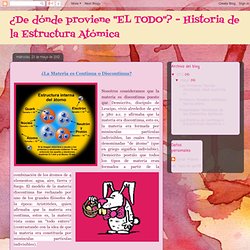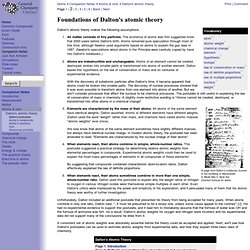

Mayo 2012. Propiedades Periódicas de los Elementos Químicos Las principales propiedades periódicas estudiada en los elementos químicos son: 1.Radio atómico 2.Radio iónico 3.Potencial de ionización. 4.Afinidad electrónica 5.Electronegatividad y carácter metálico.

El estudio de la materia y de sus propiedades en el mundo occidental , empezó ya en la antigüedad , siglo V con los griegos . DÖBERNIER en 1829 , hizo la primera clasificación de os elementos en triadas , conjunto de tres elementos de propiedades muy similares. Li Ca Cl S Na Sr Br Se K Ba I Te NEWLAND , 1866 , formuló la ley de las octavas. MENDELEIEV Y MEYER , 1869 , tomando de partida los estudios anteriores establecieron la primera tabla de elementos basándose en: Everythingscience.co.za/grade-10/04-the-atom/04-the-atom-02.cnxmlplus.
It is important to realise that a lot of what we know about the structure of atoms has been developed over a long period of time. This is often how scientific knowledge develops, with one person building on the ideas of someone else. We are going to look at how our modern understanding of the atom has evolved over time. The idea of atoms was invented by two Greek philosophers, Democritus and Leucippus in the fifth century BC. The Greek word ατoμoν (atom) means indivisible because they believed that atoms could not be broken into smaller pieces. Nowadays, we know that atoms are made up of a positively charged nucleus in the centre surrounded by negatively charged electrons. Definition 1: Model A model is a representation of a system in the real world. For example, an atomic model represents what the structure of an atom could look like, based on what we know about how atoms behave. The World of Chemistry: Essentials: Essentials - Melvin D. Joesten, John L. Hogg, Mary E. Castellion.
History of the Atomic Model. William Hunt, 8th Science Ernest Rutherford Ernest Rutherford was a british chemist and physicist.

He was born on August 30, 1871in Brightwater. And died on October 19, 1937 in Cambridge. He Discovers that an atom has a dense positively charged center known as the nucleus. John Dalton John Dalton was an English chemist, meteorologist and physicist. J.J Thomson Sir Joseph John "J. Niels Bohr Niels Bohr was a Danish physicist. Louis de Broglie Louis de Broglie was a french physicist and a Nobel laureate in 1929. Erwin Schrödinger. Companion Notes: Atoms & ions: Dalton's atomic theory: Dalton's postulates. Page 1 | 2 | 3 | 4 | 5 | 6 | Back | Next Dalton's atomic theory makes the following assumptions: All matter consists of tiny particles.

The existence of atoms was first suggested more that 2000 years before Dalton's birth. Atoms remained pure speculation through most of this time, although Newton used arguments based on atoms to explain the gas laws in 1687. (Newton's speculations about atoms in the Principia were carefully copied by hand into Dalton's notebooks.) Unfortunately, Dalton included an additional postulate that prevented his theory from being accepted for many years.
A consistent set of atomic weights was absolutely essential before the theory could be accepted and applied. Atomic theory Timeline. Dalton's Model. Notice the big old gap between the time when Democritus first shouted, "Atomos!

We've got atomos here! " to the publication of Dalton's more formal theory? Told you Aristotle threw us back into the atomic dark ages a bit. It's not that nobody was thinking about atoms at all for nearly 2000 years (check out that expanded timeline), but what Dalton discovered and what he formally published about atoms earns him the next slot on our field trip through the history of atomic models. His Experiment: Observing Chemical Reactions Dalton spent a lot of time in his lab observing various chemical reactions.
His Model: Billiard Balls Where Dalton and Democritus would have agreed (if they hadn't been separated by 2000 years) is that atoms were the smallest, most basic unit of matter. John Dalton (British scientist) Atomic theory By far Dalton’s most influential work in chemistry was his atomic theory.

Attempts to trace precisely how Dalton developed this theory have proved futile; even Dalton’s own recollections on the subject are incomplete. He based his theory of partial pressures on the idea that only like atoms in a mixture of gases repel one another, whereas unlike atoms appear to react indifferently toward each other.
This conceptualization explained why each gas in a mixture behaved independently. Although this view was later shown to be erroneous, it served a useful purpose in allowing him to abolish the idea, held by many previous atomists from the Greek philosopher Democritus to the 18th-century mathematician and astronomer Ruggero Giuseppe Boscovich, that atoms of all kinds of matter are alike. The problem remained, however, that a knowledge of ratios was insufficient to determine the actual number of elemental atoms in each compound. Later years Sydney Ross.